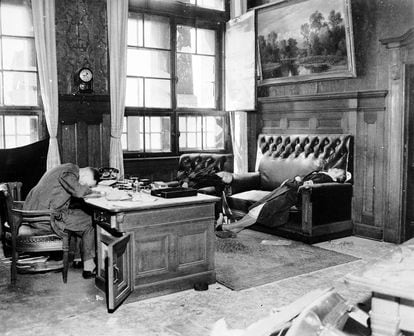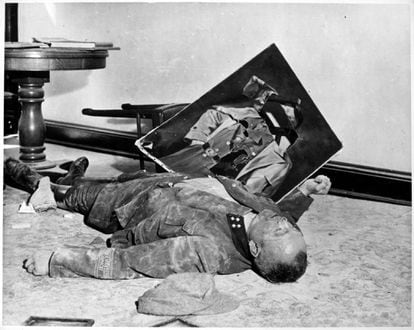The mass suicides by ordinary citizens in the last days of Nazi Germany
Historian Florian Huber’s book examines how civilians took their own lives in greater numbers than military and government officials as the Third Reich collapsed
/cloudfront-eu-central-1.images.arcpublishing.com/prisa/XJAJUXD7RVFSFCQQOZCJWCWGFU.jpg)

Most people have heard how many top Nazis such as Hitler, Himmler, Goebbels and Goering took their own lives at the end of the Third Reich, and how some defeated military commanders such as Model, Rommel and Kluge did the same. Moviegoers and history buffs may also know that Tresckow and Beck, two leaders of the failed Hitler assassination plot – Operation Valkyrie – also committed suicide. Downfall (Der Untergang), a 2004 German-language historical war drama film, depicts the final days of Adolf Hitler and his staff holed up in the subterranean bunker headquarters known as the “Führerbunker.” Scene after scene shows Hitler and many government and military officials committing suicide by pistol and poison after learning of Germany’s defeat. Yet most suicides in the bloody twilight of National Socialist Germany were by ordinary people – a housewife who drowned her young children and then hanged herself, or an entire family consuming poison in one final, fatal gathering.
In Promise Me You’ll Shoot Yourself: The Downfall of Ordinary Germans, 1945, German historian Florian Huber tells the story of the tens of thousands of civilians who killed themselves in a collective madness driven by hopelessness and fear of Soviet Army revenge. Huber, a producer of several international award-winning documentaries, begins his book in the small town of Demmin (northeastern Germany), where a shocking wave of 700 suicides took place – 10% of the population – as the Soviet Red Army closed in on the town. People of all ages, professions and classes killed themselves, often taking their babies and children to their graves. “It was as if the will to die had overcome everyone,” writes Huber.
The young wife of a Wehrmacht lieutenant strangled her three-year-old son with a rope and then hanged herself. A 71-year-old health insurance administrator, his wife and daughter all hanged themselves after killing their young grandchildren. In the Günther family home, 12 people died – some poisoned themselves, some slit their wrists, and some were shot with a hunting rifle. Huber describes the horror of a witness to multiple gang rapes by Soviet soldiers (almost two million German women were sexually assaulted at the end of the war). Afterward, many of the rape victims staggered down to the Tollense River and drowned themselves. Some led their children by the hand into the river after loading stones into their pockets, purses and backpacks, unwittingly emulating Virginia Woolf’s suicide in 1941.
These are just a few of the gruesome scenes recounted by Huber, who was most deeply affected by one dreadful story. “The groundskeeper for the Demmin cemetery kept a list of all the dead who arrived in those terrible times. There were hundreds and hundreds of names – men, women and children – and their ages and cause of death. It was a horrific, handwritten list. Number 135 on the list was a girl, barely a year old, who died on May 1, 1945, ‘strangled by her grandfather,’ it says. It affected me so much that I couldn’t even include it in the book, and it still haunts me to this day.”

The mass rape of German women by conquering soldiers, especially Soviet soldiers, followed by mass suicides, became a taboo subject in post-war Germany, as vividly described in Antony Beevor’s, The Fall of Berlin 1945. “They were completely taboo subjects for decades in our country. The stories were banned in communist East Germany because they would have reflected poorly on the glorious Red Army. Later on, no one wanted to talk about the mass suicides because those who took their lives didn’t fit with the preconceptions of Germans living under the Third Reich – they were neither villains nor victims,” said Huber. “As a result, they were forgotten until I published my book.” How many people are we talking about? “My research clearly indicates that the number must be in the tens of thousands, from all over Germany. However, in the chaotic final days of the war, official statistics, documentation and medical reports almost ceased to exist. So, it’s impossible to give an exact figure.”
Surprisingly, more civilians and ordinary people committed suicide than members of the military. “One of my most startling findings is that the phenomenon was by no means limited to hardcore Nazis, who really had a lot to fear. In fact, it was men, women and children alike, young and old, workers and businessmen, nurses and doctors, a kaleidoscope of German society. It could hit anybody. These mass suicides were by no means exclusive to Nazis, but were the outcome of a widespread feeling of doom throughout German society.”
The mass psychology of Nazism
Huber’s book explains the mass psychology of Nazism that led inexorably to suicide after defeat. “Let’s not forget that during the Third Reich, the German people had lived in a permanent state of emergency and turmoil for 12 years. During the first few years before the war, everything was hope and glory, devotion and love for the Führer. At the outset of the war, there was an overwhelming feeling of pride, power, superiority and hatred. Then, in the last years of the war, those feelings were replaced by pain, fear, despair and even self-loathing. This all culminated in the devastating experience of the annihilation facing the hallowed fatherland.”
There were many more suicides in the Soviet-occupied areas of Germany than in the Allied-occupied areas, says Huber, even though one of the best-known multiple suicides happened in the Leipzig town hall, one of the cities taken by American forces. “For years, Nazi propaganda had hammered fear of the ‘Mongol monsters’ into the hearts of the German people. When the Red Army finally crossed into Germany from the east, Soviet soldiers did in fact commit many atrocities against civilians. There is no doubt that there were more suicides in Soviet-occupied Germany than elsewhere. Again without having exact figures, I estimate that the ratio must be at least 20 to 1, even though some of the most dramatic and rare photos of German suicides were taken in Leipzig. As I write in my book, two female war photographers traveling with the Allied troops – Lee Miller and Margaret Bourke-White – took those unforgettable pictures of Germans, including entire families, who had killed themselves just minutes earlier. It’s remarkable that the best photos of this phenomenon were taken by two women.”
The current suicide epidemic leads us to wonder how easy it might be to take your own life. But how could so many people make such a terrible decision and then actually carry through with it? “Committing suicide is never easy and whoever does it must be in an extreme mental state,” said Huber. “In 1945, many factors in Germany converged to create this state of mind: fear of violence and Russian revenge, a feeling of guilt and complicity, hopelessness, and the loss of homes and loved ones. This all produced a certain contagious atmosphere, and when so many people are killing themselves, people tend to follow.” As one witness to those dark days observed: “Death has lost its majesty and has become an everyday event.”

“People used any available means to kill themselves: hanging, shooting, stabbing, slashing wrists, poisoning and drowning. Many even killed their children first,” said Huber, who deliberately focused on ordinary Germans instead of military or political figures. “But of course, many high-ranking officers committed suicide as well, By one count, 53 army generals, 14 air force generals, and 11 admirals killed themselves, and these were only the top-level officials.”
Downfall vividly depicts the horrific self-extermination of the Goebbels family as Magda Goebbels, that Medea of Hitlerism, poisons her own children. “Some Nazis committed suicide when they learned that Hitler was dead, because they wanted to continue following their Führer,” said Huber, “but Adolf Hitler’s demise had little to do with the mass suicides because many Germans no longer cared about the leader, and because radio broadcasts reported that he died heroically in battle, not by his own hand. So Hitler’s death was a final, big lie.”
There are other historical events similar to the German mass suicides, said Huber. In 73 AD, a thousand people in the Jewish fortress of Masada killed themselves while under siege by the Romans. During the 1945 Battle of Okinawa, many Japanese civilians, including entire families, committed suicide as Japanese defenses crumbled. Could this happen today? “I don’t see any conflict today that would provoke a reaction on that scale,” said Huber. “The circumstances of Germany’s defeat in 1945 were exceptional and are unlikely to be repeated.”
/cloudfront-eu-central-1.images.arcpublishing.com/prisa/MLX7L7FF3ZCFBKRLGDHPWTZ7XQ.JPG)
/cloudfront-eu-central-1.images.arcpublishing.com/prisa/K4BECBY6QRH2VOGKLD45WN5A5E.jpg)










































